HOME|Ideas and resoueces for planetary science experiments|Research of Environment of Night Sky
宇宙の実験教室
Ideas and resoueces for planetary science experiments
カテゴリ
Category
- 実験教室Idea and Resources for Space science experiments
- 対象項目別Category: Contents
- 学年単元別Category: Study Age
-
- 実践授業Activity Reports
タグ
Tag
 夜空の明るさを調べよう
夜空の明るさを調べよう
ねらい
自分たちの住んでいる地域の夜空の明るさを調べ、光害(ひかりがい)を考えましょう
夜空メーターは夜空の明るさと夜空メーターの発光ダイオードの明るさを比較することで、夜空の明るさを数値で表すことができる装置です。この装置によって、多くの地点や方角、そして時間による夜空の明るさの違いを比較することができます。
夜空メーターを使って夜空の明るさを測定し、観察した地域の星空環境と光害(ひかりがい)の度合いについて考えてみましょう。
星の見やすさと夜空の明るさ
夜空が明るい場所(例えば街)と暗い場所(例えば山の中)ではどちらの方が星が見えやすいでしょうか。
明るい中で明るいものを見るより、暗い中で明るいものを見る方が見えやすいですね。例えば、外からビルの窓を見て、電気の付いている部屋を探すとしましょう。昼と夜とではどちらが簡単に探せるでしょう?昼は外も明るいので、同じく明るい窓を外の明るさと区別するのは難しいですね。夜なら外は暗いので簡単に見分けが付きます。これと同じことが夜空と星にもおこっているのです。星の光はビルの窓よりずっと小さいですから、まわりの明るさと区別するのはもっと難しいです。夜空が明るければ弱い光の星は見えにくくなってしまいます。
電灯や照明器具によって、夜間にも活動ができるようになったり、より安全に暮らすことができるようになりましたが、一方では、必要以上に設置された電灯によって、夜空が明るくなりすぎて、星が見えにくくなってしまう害(光害(ひかりがい))の影響を受ける地域も多くなってきました。
自分の住んでいる地域の夜空の明るさを調べ、光害の影響について考えてみましょう。
夜空メーターの使い方
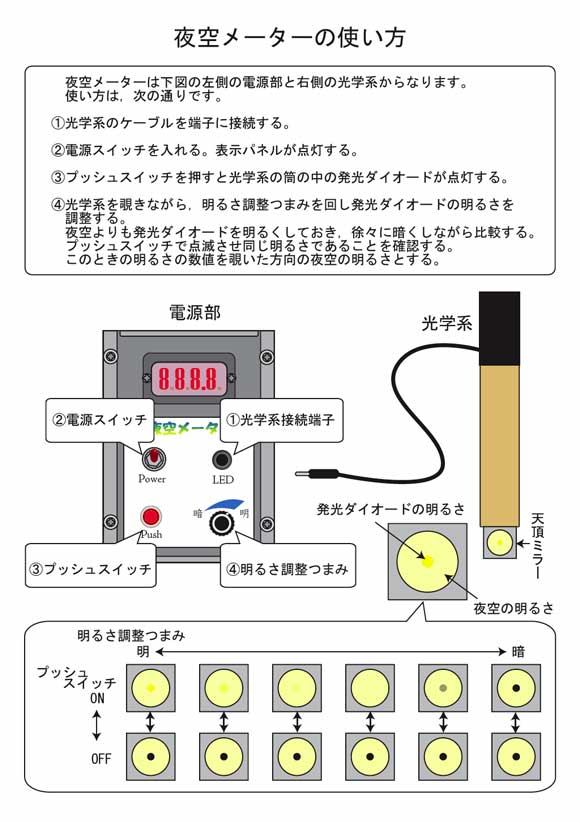
実験方法
用意するもの
赤いフィルムを貼った懐中電灯(電球側を赤いマニキュアで塗っても良い)、筆記用具、記録用紙、夜空メーター、方位磁針、星座早見盤
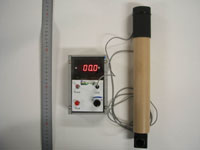
調査する場所
ふだん生活しているところから測ってもらうのが一番です。できれば、ある程度広く見回せるところがいいですね。
調査する日の天候
晴れの雲のない日が一番ですが、自分の都合の良い日で快晴を待っていたら、ほとんど観測できなくなってしまいます。雲があるときは、記録用紙に「東の空に薄雲」のように、メモをしておきましょう。
調査する空の方向
記録用紙には、北 高度10度・西 高度10度・南 高度10度・東 高度10度・天頂と代表的な星の方向、北極星・ミザール・カシオペヤ座γ・ベガ・アルタイル・デネブ・ペガスス座α・フォーマルハウト・アルデバラン・カペラ・おひつじ座αが載っています。
すべての方向が測定できない場合は、天頂だけでも測定してみてください。
東西南北の「高度10度」については、腕を伸ばし手を握ったとき小指が地平線だとすると親指が約10度になります。また夜空メータを覗いたとき、見える範囲の端から端までが約7度です。
調査をする前に
空の暗いところをしばらく見て、目を慣らしましょう。
記録用紙に調査結果を書くときや、星座早見盤を見るときに灯りが必要な場合は、赤い光の懐中電灯を使います。
観察結果
2005年9月28日の夜空の明るさ観測結果
下の表は2005年に実施した夜空の明るさ協同観測結果の一部です。2005年9月28日の21:00および23:00の宮城県栗原市、仙台市泉区、仙台市青葉区仙台駅屋上、仙台市青葉区宮教大屋上、福岡市南区での観測結果を示しています。
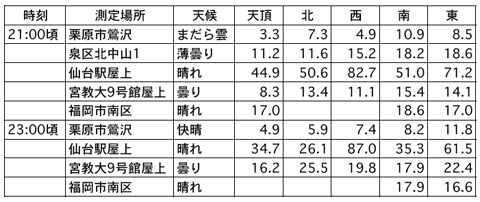
同じ仙台市青葉区でも、駅前と駅から離れた宮教大屋上とでは夜空の明るさが一桁違うのが分かりますね。
結果の整理(1)
地域ごとの天頂の明るさ(2005年9月28日21:00頃)
得られた結果から、地域ごとの天頂の明るさを比べてみましょう。
下の図は2005年9月28日21:00頃の測定値を数値によって色分けし、各測定場所にプロットしたものです。
測定場所をもっと増やせば、ある時間の天頂の明るさを示す星空環境マップを作ることができますね。あなたの住んでいる町の星空環境マップを作ってみましょう。
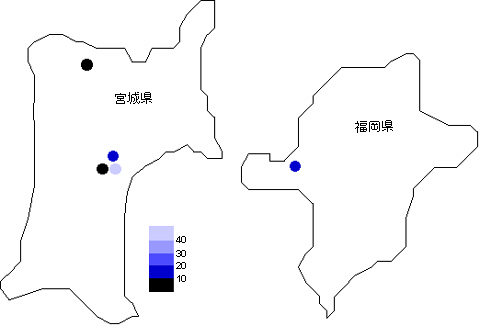
結果の整理(2)
全天の夜空の明るさと時間変化
全天の夜空の明るさの時間変化を調べてみましょう。下の図は2005年9月28日の宮教大屋上と栗原市鶯沢における21:00と23:00の観測結果を全天を示すグラフにプロットしたものです。外側の円が地平線を表し、中心に向かって高度30度、60度、90度、中心が天頂です。測定値を10mVごとに色分けしています。
宮教大屋上と栗原市鶯沢では夜空の明るさに差があることがよく分かりますね。また、21時頃は仙台市の中心部からの光のせいか、宮教大屋上の東から南の空が明るいですが、23時になると少し暗くなって星空環境が良くなっていることがわかります。
東西南北天頂の他に、一等星の方向の夜空の観測地を加えてプロットすれば、もっと詳しく全天の夜空の明るさを視覚的にとらえることができます。
| 仙台市青葉区 宮教大屋上 | |
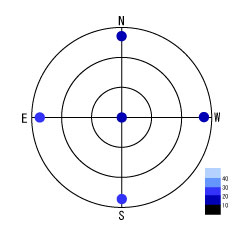 |
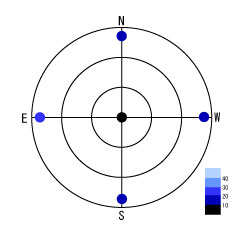 |
| 21:00 | 23:00 |
| 栗原市鶯沢 | |
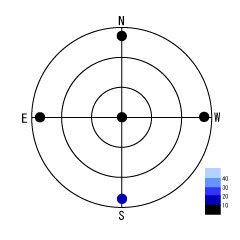 |
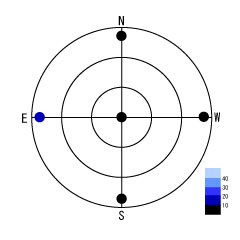 |
| 21:00 | 23:00 |
関連項目
 Research of Environment of Night Sky
Research of Environment of Night Sky
ntroduction
Check out the darkness of night sky in your local area and see how much it is affected by Light Pollution.
Dark Sky Meter is a device that can show the brightness (or darkness) of the night sky by the numerical value by comparing the brightness of the night sky with the brightness of the light emitting diode of the night sky meter. The difference of the brightness of the night sky according to a lot of points, directions, and time can be compared with this device.
Determine the darkness of night sky by Dark Sky Meter and think about the night sky environment and see how much it is affected by Light Pollution.
The Visibility of a Star and Darkness of Night Sky
Where can you see more stars, in the town with a less dark night sky, or in the mountains with a darker night sky?
You can see something bright in a dark place more easily than in a bright place. For example, when you are looking for a room light on by seeing windows of the building from outside, which is easier, looking for it in the daytime or the evening? Because it is bright outside in the daytime, it is difficult to distinguish a bright window from outside. You can easily distinguish a bright window from dark outside when it is evening. Something similar happens between the night sky and stars. Light from a star is much fainter than a building window, so recognizing it is more difficult. If the night sky is not dark enough,faint stars can not be seen well any more.
We can work and live more safely at night with artificial lights, on the other hand, more and more night sky get too brighter by too many lights, so we can not see a lot of stars(Light pollution) .
How to use Dark Sky Meter
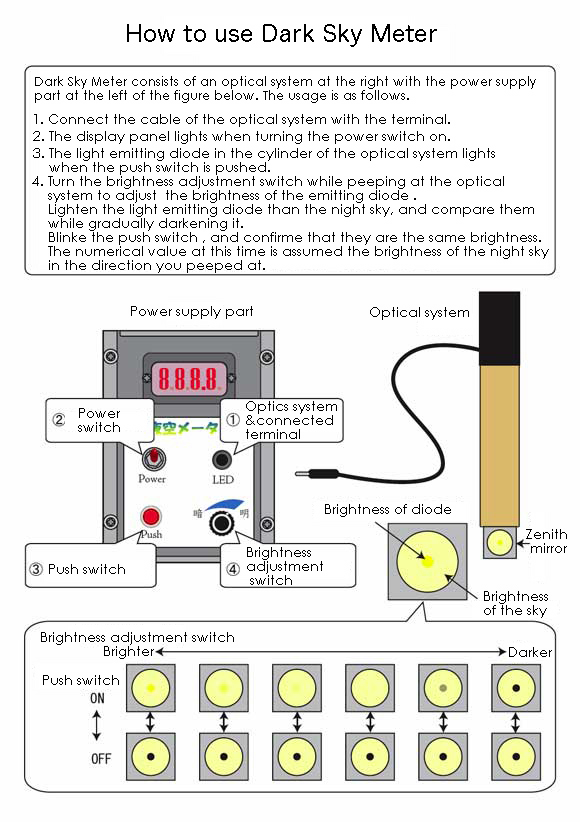
Experimental Method
Things to prepare
Torch with red film (Or, you can paint the light side with red paint. )、Pen and pencil set、Observing Report Sheet、Dark Sky Meter、Compass、Star map

Research point
It is the best that you measure from the place where you live normally. If possible, it is best if you have a clear view of most of the sky from there.
Weather of the research day
A clear day without any cloud is the best, however, you will not have many observations if you wait on such a fine day. Just take notes on the observing report sheet like "In the eastern heavens thin clouds" when there is a cloud.
Research directions of the sky
Make observations at the zenith and in the directions north, south, east and west at ten degrees altitude, using standard stars such as the Pole Star, Mizar, the Cassiopeia γ, Vega Altair Deneb, the Pegasi α, Fomalhaut, Aldebaran, Capella, and the Arietis α and record your observations on the Observing Report Sheet.
When you can not measure all the directions, just check the direction of zenith.
You can measure "The ten degrees" of north, south, east, and west like this: when you stretch out your arm and clench your fist, when your little finger is level with the horizon, then the thumb becomes about ten degrees. Moreover, when peeping through the Dark Sky Meter, the field of view of the scope is about seven degrees from one side to the other.
Before the research
Sit in a darkened area for a while, to allow your eyes to become dark-adapted.
When you need light to write the results on paper or to see a star map, use a red light torch.











